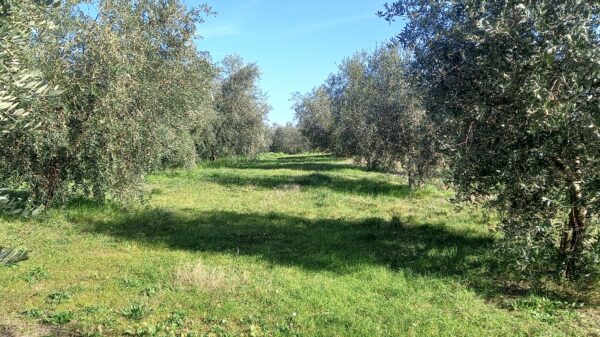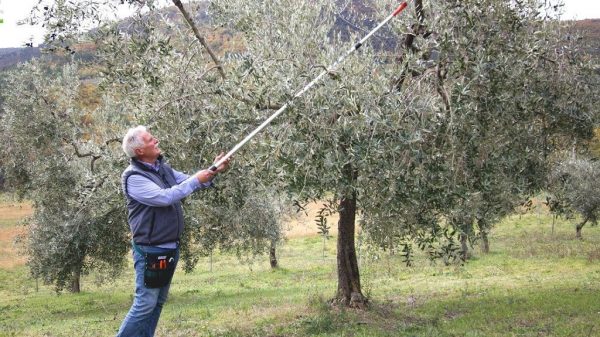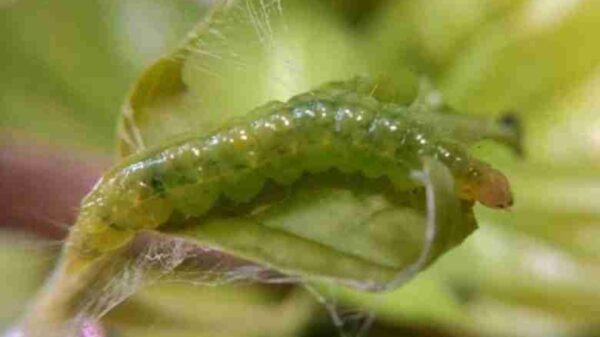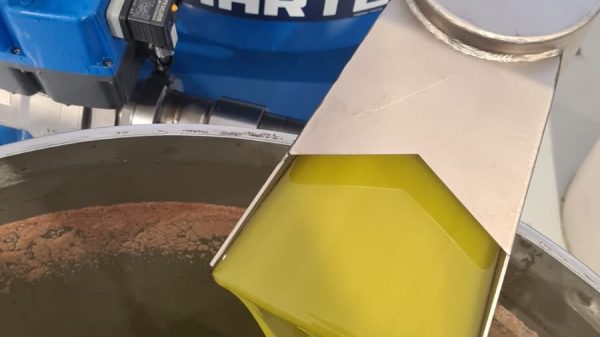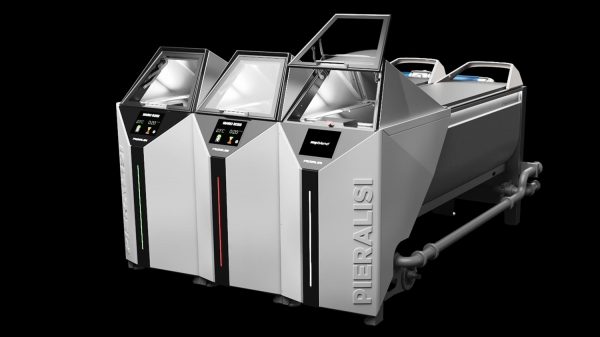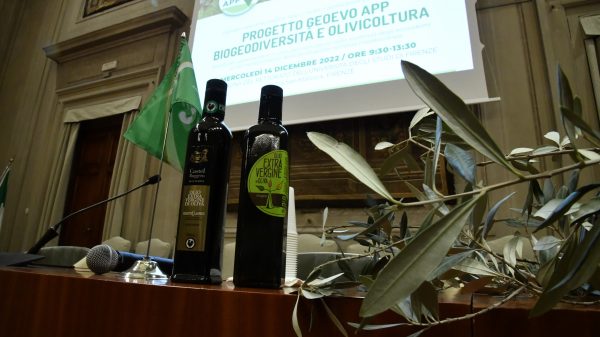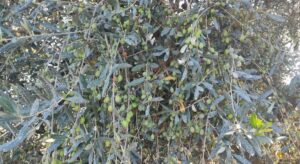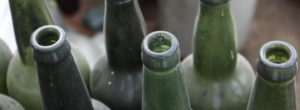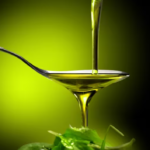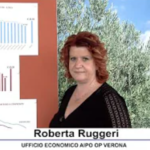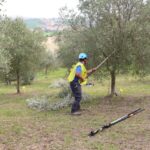by Matteo Zucchini and Enrico Maria Lodolini
Department of Agricultural, Food and Environmental Sciences
Marche Polytechnic University


Extreme weather phenomena may increase in the near future. If on the one hand an increase in average temperatures is expected which may allow the cultivation of olive trees towards the north, on the other hand we must expect a greater intensity and frequency of winter frosts, and especially of late spring ones. Although the winter temperatures useful for overcoming the dormancy of the flower buds will hardly be lacking throughout the peninsula, the return to cold temperatures in late spring can instead jeopardize production by affecting the floral structures.
In this context of climate change and global warming, even in olive growing it is necessary to implement unconventional agronomic techniques to increase the resilience of the olive grove.
In the last century, 5 "catastrophic" frosts have been recorded for the olive tree in central Italy (in the years 1929, 1956, 1985, 2012 and 2018). These frosts caused damage to the olive trees, often forcing the farmer to start from scratch by carrying out very intense pollarding.
The olive tree, despite being an evergreen species, is well suited to the cold winters of central and southern Italy. Some organs of the plant can withstand temperatures as low as -17° C with a plant well acclimated to the cold (series of physiological processes of hardening of the tissues and accumulation of certain substances in the cells which ensure that the plant can withstand such temperatures).
Cold damage, if very serious, is evident on trunks, branches and branches; if of lower intensity they can manifest themselves with browning and/or chlorosis of the leaves. Late cold damage to inflorescences, individual flowers or pistils (and ovaries) is little recognised.
Furthermore, after significant frosts (such as those of 2012 and 2018 in the Marche region) there was a strong attack of gannet mange on damaged structures (causative agent Pseudomonas savastanoi pv. savastanoi).
If the trunk and branches can also withstand temperatures of -17° C during mid-winter and -7°/-10° C in spring, the buds and leaves cannot tolerate temperatures below -2°/-3° C during vegetative growth.
The inflorescences, on the other hand, appear to be sensitive to temperatures close to or below zero, even if it is not clear what the threshold temperatures and residence times at this temperature are to induce visible damage to these structures. The other aspect to consider is the different susceptibility of the cultivars.
In a study presented at the “IX International Olive Symposium” held at the UC DAVIS University in California by the Arboriculture and Olive Growing group of the Polytechnic University of Marche, the results of measurements carried out on the inflorescences of some varieties of olive trees were reported following a late return of cold in various locations in the Marche in 2022 (figure 1).
In particular, on 11 April 2022, night temperatures around 0 were recorded in several areas of the Marche region (figure 2). In this period the olive inflorescences were already at an advanced stage of development.
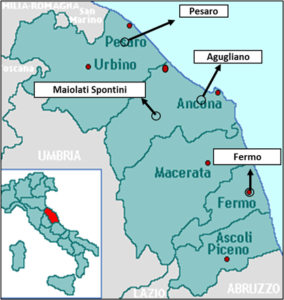
Fig 1
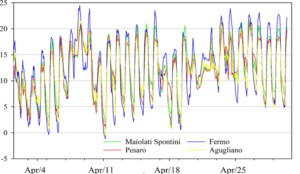
Fig.2
The temperatures recorded did not damage vegetative tissues such as shoots or leaves, but did affect the inflorescences.
Although temperatures below 0°C were not recorded in all the locations considered, the damage to the inflorescences appears to be distributed homogeneously in all the olive groves monitored, except in the one facing north (called Fermo LDN).
From the results of the observations, the greatest damage was found in Agugliano (AN), where a minimum of -0,7° C was recorded. Fermo was among the areas most subject to the return of cold temperatures. In fact, in this area a minimum temperature of -1,2° C was recorded even if, as we will see later, there were significant differences in various locations in this area within a distance of one kilometre.
Although significant differences were found between some cultivars, it is not possible to say from the evaluation which cultivar is the most tolerant to late cold returns. Arbequina, for example, was among the least tolerant varieties in Agugliano, while in Fermo it was among the most tolerant (even if a personal communication reported a total absence of fruit production of all varieties in this olive grove).
Precisely in Fermo there was a paradoxical situation: the olive groves in question were all within a radius of about 3,5 km on the hills, but unlike the olive groves facing south, the one facing north showed no damage. The plants of this olive grove were probably in a later phenological phase compared to those of the south-facing olive grove, and the daily temperature difference was not such as to cause damage to the inflorescences. It should also be noted that the temperature of the olive groves facing south was recorded at the bottom of the valley, and that while at that point -1,2° C was recorded 1,2 km away, in the city of Fermo there were + 7,5° C. This aspect underlines the great variability of the climatic conditions in the different micro-areas of the same area (let alone between areas within the same Marche region) and the different incidence in terms of damage to the inflorescences of the olive tree which can occur.
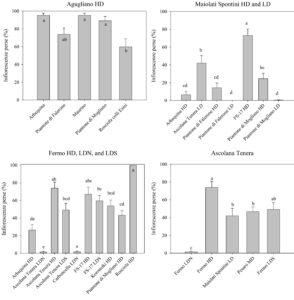
From the temperatures and damage recorded in the olive groves considered, it is possible to conclude that 2° C probably represents the threshold temperature below which damage to flowers and inflorescences can occur. Returns of cold between the beginning and mid-April (with fully formed inflorescences in the olive tree) are becoming very frequent in the Marche. In addition to 2022, the year to which the results indicated in this article refer, a sudden drop in temperature was also recorded in 2023 in the period in question, with significant damage to the inflorescences of olive trees and strong repercussions on production which in many areas have been reset. This problem was less marked if not completely absent in the olive groves of the more internal areas of the region, characterized by a delay in vegetative growth and the emission/development of inflorescences.
From the observations made, we can also underline the importance of having timely weather data for your olive grove, with the possibility of warning if any temperature parameter is approaching threshold levels.
In order to act as precisely as possible in the event of a late frost, it should be possible to evaluate the type of frost that is occurring (extent of the temperature difference and duration of time below the threshold temperature) and the phenological phase in which the olive trees are ( acclimatization with vegetative stasis, vegetative growth, emission and development of inflorescences, etc.).
It is then possible to implement a series of agronomic measures to minimize the plants' susceptibility to the return of cold weather. For example, fertilizations should avoid the availability of nitrogen at the end of the season and instead favor that of phosphorus and potassium to harden the tissues, thus increasing tolerance to winter and spring cold.
It is then possible to think about using foliar treatments with geo-materials such as kaolin, zeolite or rock flour or with products based on sugars, polyols, or other polymers. Such treatments could have the function of protecting tissues from ice formation or lowering the freezing point of water within various organs.
A strategy could also be developed to reuse the prunings as fuel for candles that heat the olive grove and create the smoke necessary to prevent temperatures from falling below the critical threshold (circular economy system).
REFERENCES
Zucchini, M., Lodolini, E.M., Giorgi, V., Gobbi, L., Valverde, P., Neri, D. 2023. Response of different olive cultivars to late frosts in the Marche region (Italy). IX International Olive Symposium 2023, Davis (CA-USA), 10-14 September, 2023.
Lodolini, E. M., Alfei, B., Santinelli, A., Cioccolanti, T., Polverigiani, S., & Neri, D. (2016). Frost tolerance of 24 olive cultivars and subsequent vegetative re-sprouting as indication of recovery ability. Scientia Horticulturae, 211, 152–157. https://doi.org/10.1016/j.scienta.2016.08.025
Lodolini, E. M., Alfei, B., Cioccolanti, T., Zucchini, M., & Neri, D. (2022). Comparison of frost damage in eleven olive cultivars after two freezing events in central Italy. Acta Horticulturae, 1346, 161–167. https://doi.org/10.17660/ActaHortic.2022.13
Valverde, P., Zucchini, M., Polverigiani, S., Lodolini, E. M., López-Escudero, F. J., & Neri, D. (2020). Olive knot damage in ten olive cultivars after late-winter frost in central Italy. Scientia Horticulturae, 266(October 2019), 109274. https://doi.org/10.1016/j.scienta.2020.109274
Zucchini, M., Maoloni, A., Lodolini, E. M., Ferrocino, I., Aquilanti, L., & Neri, D. (2023b). Knot formation and spread along the shoot stem in 13 olive cultivars inoculated with an indigenous pathobiome of 7 species of Pseudomonas including Pseudomonas savastanoi. PLoS ONE, 18(8 August), 1–17. https://doi.org/10.1371/journal.pone.0289875
Browse for free l'Olivo News click , here
